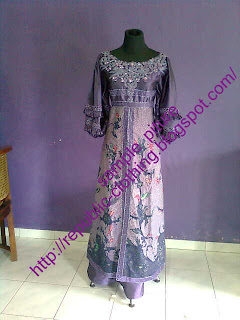Size required for the system pattern Dressmaking
a) Neck Circumference: 38 cm
b) face width: 33 cm
c) Ring body: 88 cm
d) chest Height: 15 cm
e) Waist: 66 cm
f) hip circumference: 96 cm
g) High hip: 16 cm
h) back Width: 34 cm
i) Length of back: 37 cm
j) The length of skirt: 50 cm
k) shoulder length: 12 cm
l) Length of arm: 24 cm
m) High peak arm: 12 cm
Notebook: The above measure is a measure to learn to draw basic patterns of adult women's clothing. So to make your own clothing patterns only replace the numbers according to your size

Description of Pattern
Drawing patterns Dressmaking system starts from the back pattern, but previously determined general guidelines are ½ size circumference body that starts with a dot.
A - B = ½ the size of the circumference of the body.
A - C = ¼ body circumference plus 1 cm.
B - B1 = 1.5 cm.
B1 - D = length of the back, make a horizontal line ketitik E.
B - B2 = 1 / 6 the circumference of the neck plus 1 cm.
Connect the dots B1 to B2 as the picture (behind neck).
C - C1 = 5cm, connect it to the point of B2 with a dotted line (help lines).
B2 moved the length of the shoulder through help lines are named point B3
B3 - B4 = 1 cm, equate the size of the B2 to B4, and connected with a fine line.
B1 - G = back plus 1 ½ cm long, make a left horizontal line and name the point H.
B1 - G1 = 9 cm.
G1 - F1 = ½ width of the back (for the line width of the back).
Perimeter shape concave rear arm from the point B4 to F1 continue to F as shown.
D - D1 = ¼ waist size plus 3 cm (large pleated coup) minus 1 cm.
D - D2 = 1 / 10 waist.
D2 - D3 = 3 cm (large pleated coup).
Of D2 and D3 divided by 2, made the dashed line to the body line (G and H) were measured 3 cm down, connected with dots D2 and D3 to pleated coup.
D - D1 = waist size plus ¼ 3 cm.
D1 associated with F, a line the back side of the body.
Description of the face pattern
A - A1 = 1 / 6 the circumference of the neck plus 1 cm.
A - A2 = 1 / 6 the circumference of the neck plus 1.5 cm.
Connect the dots A1 to A2 as a picture (face pattern neckline).
A1 - C2 = length shoulder.
A2 - A3 = 5 cm.
A3 - F2 = ½ width of the face.
Connect the dots C2 to continue F2 to F as the picture (concave arm circumference of the face).
E - E1 = 2 cm (as big as the size of the coup side).
E1 - E4 = ¼ waist circumference plus 4 cm (3 cm large pleated coup and 1 cm to distinguish patterns of face-to-back).
E1 - E2 = 1 / 10 waist.
E2 - E3 = 3 cm (large pleated coup).
E2 and E3 be divided by two dotted lines to the center line of the shoulders.
A2 - J = chest height.
From A line made up to J1.
J1 - J2 = 2 cm, then connected with the points E2 and E3 form a pleated coup.
F - I = 9 cm, then connected with a dotted line to the point J1.
J1 - K = 2 cm.
From I to I1 and I2 measured each 1 cm, then connect with the point K.
I1 - K = I2 - K, which was long used as a benchmark to measure I1 K.
E4 is connected to the I2 and I1 with the F point, a line side of the face.




























